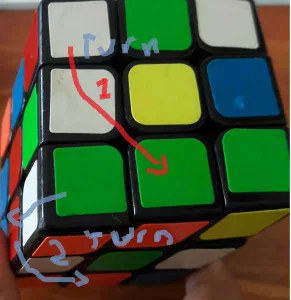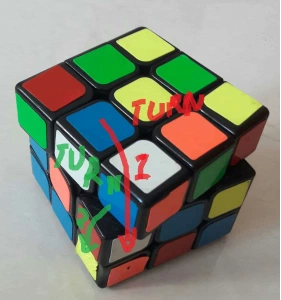3x3x3 Rubik’s Cube
If you ever wondered how people solve the Rubik’s cube you need to use some of your brain and some algorithms you might get confused but it’s ok it the easiest way of solving the 3x3x3 cube. you need to learn what are edges and corners in a cube

There are six faces in a 3x3x3 Rubik’s cube 12 edges and 8 corners.
- Solve the cross (plus) of the white face
- white corners
- then second layers
- finally the yellow plus, yellow plus match
- semi-match corners match.
Done!!!! the 3x3x3 cube.
the history of the Rubik’s company
Rubik’s Cube is a puzzle invented in 1974 by Hungarian sculptor and professor of architecture Ernő Rubik. Originally called the Magic Cube, the puzzle was licensed by Rubik to be sold by Ideal Toy Corp. in 1980 through businessman Tibor Laczi and Seven Towns founder Tom Kremer. Rubik’s Cube won the 1980 German Game of the Year special award for Best Puzzle. As of January 2009, 350 million cubes had been sold worldwide, making it the world’s top-selling puzzle game. It is widely considered to be the world’s best-selling toy.
On the original classic Rubik’s Cube, each of the six faces was covered by nine stickers, each of one of six solid colors: white, red, blue, orange, green, and yellow. Some later versions of the cube have been updated to use colored plastic panels instead, which prevents peeling and fading. In currently sold models, white is opposite yellow, blue is opposite green, and orange is opposite red, and the red, white, and blue are arranged in that order in a clockwise arrangement On early cubes, the position of the colors varied from cube to cube An internal pivot mechanism enables each face to turn independently, thus mixing up the colors.
Although Rubik’s Cube reached its height of mainstream popularity in the 1980s, it is still widely known and used. Many speedcubers continue to practice it and similar puzzles; they also compete for the fastest times in various categories. Since 2003, the World Cube Association, the international governing body of Rubik’s Cube, has organized competitions worldwide and recognizes world records.
Rubix cube language
Before you learn the actual Rubik’s cube you should the Rubik’s cube lingo

Solving the white face
- Solve the cross (plus) of the white face
- .white corners
cross (plus) of the white face
As the white layer, is on the downside you have to match the middle center’s ex.blue white edge you match with the white center and the blue center.
There are some cases to solve the cross
- up-down case
- normal case
- middle layer case
- bottom layer case
- up-down case bottom layer case
- normal case bottom layer case
normal case
The normal case occurs when the other color (not the white color side of the piece)you match it and since the white is on the bottom you simply turn the front layer(the layer which you matched with the piece face it as your front layer )turn it to the bottom layer

up down case
The up-down case is the opposite of the normal case. (The white part of the edge piece is facing you. ‘You bring the other piece not the white part the other one’ to the middle layer to match the other coloring the middle layer. Ex. the blue and white edge then you go to turn the top layer to the other side then if the piece is on the right do the formula R’ then do F or if the piece is on the left layer do the formula L then do F’ match the white piece

Note that when doing step which is green color there might already be matched piece and it gets out of the white so match the piece you are trying to do when there was an up-down case do L’ if it is on the left and if it on the right do R.
MIDDLE LAYER CASE
The middle layer case is a combination of the normal case and the up-down case the middle layer case occurs when there is a white and another color piece is on the middle layer. if the piece is on the left side then do L’ U’ L if it on the right then do R U R’ then you might get the normal or the up-down case
normal case bottom layer case
The normal bottom layer case occurs when the white part of the piece is matched the other part of the piece is not matched. Then you do F’2 you get the normal case.
up-down case bottom layer case
The up-down bottom layer case occurs when the white part of the piece not matched the other part of the piece is not matched too. Then you do F’2 you get the up-down case.
you are done the white cross!!!
Solving the corners of the white face
solving the corners is so simple there just two cases that can occur and if you how the white face looks when it is completed then you know solve the first layer (white face). (Keep the white on the top).
the two cases are…
- normal case
- special case
how the first layer looks…

the Grey are unsolved. A corner has three colors so let’s say that we want to solve the white, red and blue corner which is a normal use here are several type Norma cases in the normal case
so
case 1: in case one let’s say you find the blue, white, and the red corners. Let us also say that the blue corner is on the down layer and the red and white part of the corner piece is facing up. Then match the red side of the piece to the red center if you observe you will see the blue center still on the down layer. As we told that the blue part of the corner piece is on the down face side. Before doing the algorithm face the matching corner piece on the front then if t the piece on the left do (F L’ After this face white as your front the do DL) when you face the matched piece then if it is on the right then do ( F’ R After this face white as your front the do D’ R’).
case 2: in case two the white part of the is matched. Then you should place your white face on your front then do R’ B’ R then you can solve the corner like case 1.and if it on the left then do L B L’ then you can solve the corner like case 1.
case 3: when the white corner is semi matched, Semi match means it is organized to the correct center but not matched. When the white face is on your front and if the white part of the piece on the down layer then do (if it is on the right do D B D’) and if it is on the left then do ( D’ B’ D) then solve it like the case 1.
case 3.1 when it is semi matched sideways. Place your white face as the front then if see your white part of the piece facing the right then the piece is on the right then do (R’ B’ R) and if it is on the left then do (L B L’) then solve it like the case 1.
special case: Place the white layer on the top then if your white part of the corner is facing the down layer then first match to either color then you can’t match it to the white because of the white part of the piece on the down layer. After you match any 1 color part of the piece then face color-matched piece as the front face then do ( F2 R F2 R’ ) then one corner will be destroyed from its correct place then face the match normal case corner as the front face then do ( F’ R F R’)
then your first layer is done!!!
the second layer
There are just two cases in the second layer!! you are only using the edges which do not have yellow in color in them at all case 1 normal case: The normal case is when the non-yellow edges are on the yellow side. Then match the part of the piece which is not on the yellow side to its correct centerpiece. Then check the color on the yellow-side then face the matched piece as the front layer. Then if you already put the matching part as your front layer then check if the color with the top part of the piece the if the matching color is on the right then do (F then turn the cube once to the left then do U R U R U’ R’ U’ R’ then turn the cube once to the right)

